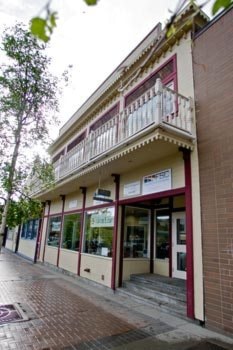Paris in the Twenties. Greenwich Village in the Fifties. Seattle in the Nineties.
Whitehorse in 2008, maybe.
Comparing the Yukon capital to those great artist and bohemian havens might be excessive, but Whitehorse certainly has earned its reputation as a Canadian arts and culture mecca.
It might help that anyone with a modicum of success (or talent) can feel like a big fish in a small pond.
Yukon Arts Centre executive director Al Cushing certainly feels his contributions mean more here than they would in other urban areas.
He left a management job at a thriving performance complex in Calgary for the smaller Yukon centre.
Smaller scale, bigger impact
“This is a community where I could do something meaningful, and it would welcome what I do,” said Cushing.
“It was a big factor in deciding to make Whitehorse the next move.
Similar efforts in Calgary, Edmonton or Ottawa would be “less rewarding,” he said.
The idea of using arts and culture as an economic driver or for revitalization for cities has become gospel for municipalities.
It’s an idea that will be reinforced at the Creative Cities Network of Canada conference held in Whitehorse on October 16 and 17.
The summit will bring more than 100 — with a goal of 200 — arts and culture administrators to Whitehorse.
One of the most effective ways to improve arts and culture policy is to share expertise and experience, said Elizabeth Keurvort, Creative City executive director.
“Cultural planning in a city can be lonely,” she said.
“In many of our cities you find one employee working on arts and culture, and sometimes he or she wears many different hats: economic development, tourism, on top of everything else.
“So the network is sort of a support group as well.”
Arts and culture is critical to the health of a community, said Keurvort.
“It has such a spillover into other areas: economic impact, health and vitality of citizens,” she said.
“People are friendlier and happier and more engaged in the community.”
Citizens do cluster where an active arts and culture scene persists in a community, like Austin, Texas, Seattle, Washington, and even Ottawa, Ontario, said Cushing.
“People are drawn to these cities because they are interesting places to be,” he said.
But to concentrate solely on an economic argument for investing in arts is to overlook a large part of the picture.
“You want to (invest) because you’re creating a quality of life,” said Cushing, who sits on the summit’s advisory committee with other local creative professionals.
Through art, music, theatre or literature, “when someone comes to Whitehorse for economic or environmental reasons, they’re hooked and they stay.”
Convincing the Creative City board of directors to host the summit in Whitehorse was easy, said Sheila Dodd, city of Whitehorse tourism and economic development co-ordinator.
“Whitehorse perceives itself as a creative city, and so does the rest of the country,” she said. “And it is.
“The conference will leave us with something we can use later on.”
Sessions on community engagement, economic development and the arts, cultural infrastructure and public arts will take place over two days.
“What does a city get in return for its arts and culture investment?” said Dodd, who sits on Creative City’s board of directors.
“How much money is spent on cultural events, and what do we get back for it?”
The Yukon receives $113.33 per person in arts funding, $100 more than the Northwest Territories — the second-best-funded province or territory, according to a report from the Canadian Public Arts Funders.
The Yukon government’s arts budget approaches $3 million.
Whitehorse will get a chance to showcase programs and events in the city to those at the conference, she added.
Attendees will tour the Sundog Retreat Carving program and the Yukon Artists at Work co-op.
A city without a healthy arts and culture scene, especially one the size of Whitehorse, would be a difficult sell to potential residents, said Dodd.
“It makes a community more attractive to people wanting to live here or invest here,” she said.
“If you’re a business and you need photos or text for a brochure, there’s a plethora of artists to chose from.”
Cities can’t afford not to invest in arts and culture, but the problem is many just can’t afford it at all, said Keurvort.
“Every municipality, because of Canada’s system, is experiencing a financial crunch,” she said.
“While there’s a greater understanding of the nuances (of arts and culture importance to city growth), there’s still a belief it can’t be afforded.”
Whitehorse has been “eminently successful, maybe by change or design” in creating a vigorous arts scene, said Cushing.
If the scene has grown through a series of fortunate events, then at least the foundation is here to build upon.
Over the years, the Yukon has increasingly embraced arts and culture as an economic and quality-of-life driver.
More than 735 people earn their living in the cultural sector, about 4.8 per cent of the Yukon labour force, according to a 2004 government report.
The national average is 3.8 per cent.
The growth is helped by the Yukon government’s willingness to fund and support arts and culture, said Cushing.
“The challenge for municipalities, the government and industry is attracting the best and brightest,” he said.
A city can be left to play catch-up as an arts scene grows without much support, said Keurvort.
“It’s catch-up, but not in a stressful way — it’s about staying abreast and employing best practices,” she said.
“If a city is going well, a community doesn’t stop.”
The public can attend the conference, but it costs $299 for the two days.
More information can be found at www.creativecity.ca.
